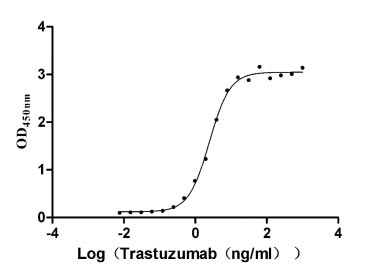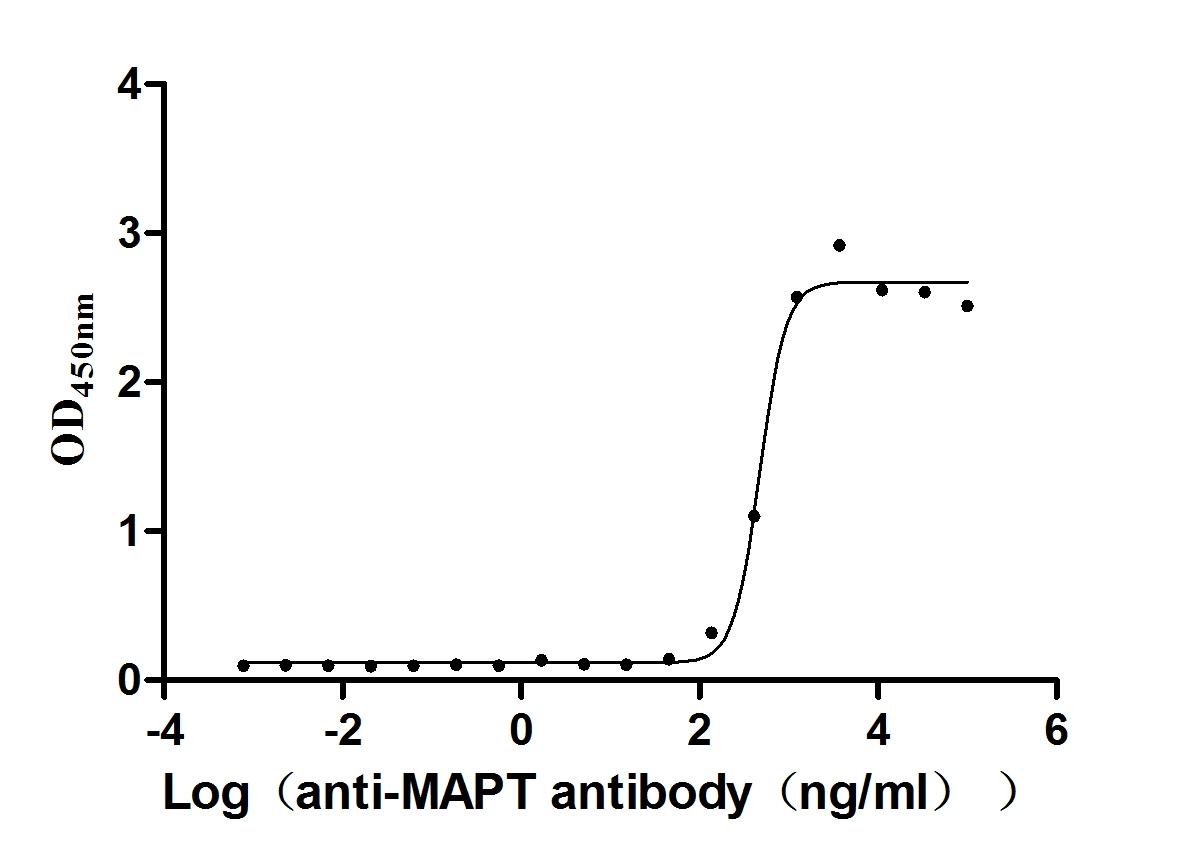Recombinant Mouse Transcription factor E3 (Tfe3)
-
货号:CSB-YP731024MO
-
规格:
-
来源:Yeast
-
其他:
-
货号:CSB-EP731024MO
-
规格:
-
来源:E.coli
-
其他:
-
货号:CSB-EP731024MO-B
-
规格:
-
来源:E.coli
-
共轭:Avi-tag Biotinylated
E. coli biotin ligase (BirA) is highly specific in covalently attaching biotin to the 15 amino acid AviTag peptide. This recombinant protein was biotinylated in vivo by AviTag-BirA technology, which method is BriA catalyzes amide linkage between the biotin and the specific lysine of the AviTag.
-
其他:
-
货号:CSB-BP731024MO
-
规格:
-
来源:Baculovirus
-
其他:
-
货号:CSB-MP731024MO
-
规格:
-
来源:Mammalian cell
-
其他:
产品详情
-
纯度:>85% (SDS-PAGE)
-
基因名:
-
Uniprot No.:
-
别名:Tfe3; Tcfe3; Transcription factor E3
-
种属:Mus musculus (Mouse)
-
蛋白长度:full length protein
-
表达区域:1-572
-
氨基酸序列MSHAAEPARD AVEASAEGPR AVFLLLEERR PAESAQLLSL NSLLPESGIV ADIELENILD PDSFYELKSQ PLFLRSSLPI SLQATPTTPA TLSASSSAGG SRTPAMSSSS SRVLLRQQLM RAQAQEQERR ERREQAAAAP FPSPAPASPA ISVIGVSAGG HTLSRPPPAQ VPREVLKVQT HLENPTRYHL QQARRQQVKQ YLSTTLGPKL ASQALTPPPG PSSAQPLPAP ETAHATGPTG SAPNSPMALL TIGSSSEKEI DDVIDEIISL ESSYNDEMLS YLPGGTAGLQ LPSTLPVSGN LLDVYSSQGV ATPAITVSNS CPAELPNIKR EISETEAKAL LKERQKKDNH NLIERRRRFN INDRIKELGT LIPKSNDPEM RWNKGTILKA SVDYIRKLQK EQQRSKDLES RQRSLEQANR SLQLRIQELE LQAQIHGLPV PPNPGLLSLT TSSVSDSLKP EQLDIEEEGR PSTTFHVSGG PAQNAPPQQP PAPPSDALLD LHFPSDHLGD LGDPFHLGLE DILMEEEGMV GGLSGGALSP LRAASDPLLS SVSPAVSKAS SRRSSFSMEE ES
-
蛋白标签:Tag type will be determined during the manufacturing process.
The tag type will be determined during production process. If you have specified tag type, please tell us and we will develop the specified tag preferentially. -
产品提供形式:Lyophilized powder
Note: We will preferentially ship the format that we have in stock, however, if you have any special requirement for the format, please remark your requirement when placing the order, we will prepare according to your demand. -
复溶:We recommend that this vial be briefly centrifuged prior to opening to bring the contents to the bottom. Please reconstitute protein in deionized sterile water to a concentration of 0.1-1.0 mg/mL.We recommend to add 5-50% of glycerol (final concentration) and aliquot for long-term storage at -20℃/-80℃. Our default final concentration of glycerol is 50%. Customers could use it as reference.
-
储存条件:Store at -20°C/-80°C upon receipt, aliquoting is necessary for mutiple use. Avoid repeated freeze-thaw cycles.
-
保质期:The shelf life is related to many factors, storage state, buffer ingredients, storage temperature and the stability of the protein itself.
Generally, the shelf life of liquid form is 6 months at -20°C/-80°C. The shelf life of lyophilized form is 12 months at -20°C/-80°C. -
货期:Delivery time may differ from different purchasing way or location, please kindly consult your local distributors for specific delivery time.Note: All of our proteins are default shipped with normal blue ice packs, if you request to ship with dry ice, please communicate with us in advance and extra fees will be charged.
-
注意事项:Repeated freezing and thawing is not recommended. Store working aliquots at 4°C for up to one week.
-
Datasheet :Please contact us to get it.
靶点详情
-
功能:Transcription factor that acts as a master regulator of lysosomal biogenesis and immune response. Specifically recognizes and binds E-box sequences (5'-CANNTG-3'); efficient DNA-binding requires dimerization with itself or with another MiT/TFE family member such as TFEB or MITF. Involved in the cellular response to amino acid availability by acting downstream of MTOR: in the presence of nutrients, TFE3 phosphorylation by MTOR promotes its cytosolic retention and subsequent inactivation. Upon starvation or lysosomal stress, inhibition of MTOR induces TFE3 dephosphorylation, resulting in nuclear localization and transcription factor activity. In association with TFEB, activates the expression of CD40L in T-cells, thereby playing a role in T-cell-dependent antibody responses in activated CD4(+) T-cells and thymus-dependent humoral immunity. Specifically recognizes the MUE3 box, a subset of E-boxes, present in the immunoglobulin enhancer. It also binds very well to a USF/MLTF site. May regulate lysosomal positioning in response to nutrient deprivation by promoting the expression of PIP4P1. Acts as a positive regulator of browning of adipose tissue by promoting expression of target genes; mTOR-dependent phosphorylation promotes cytoplasmic retention of TFE3 and inhibits browning of adipose tissue. Maintains the pluripotent state of embryonic stem cells by promoting the expression of genes such as ESRRB; mTOR-dependent nuclear exclusion promotes exit from pluripotency. Required to maintain the naive pluripotent state of hematopoietic stem cell; mTOR-dependent cytoplasmic retention of TFE3 promotes the exit of hematopoietic stem cell from pluripotency.
-
基因功能参考文献:
- TFEB and TFE3 collaborate with each other in activated macrophages and microglia to promote efficient autophagy induction, increased lysosomal biogenesis, and transcriptional upregulation of numerous proinflammatory cytokines PMID: 27171064
- These data indicate that TFE3 and TFEB play a cooperative, rather than redundant, role in the control of the adaptive response of whole-body metabolism to environmental cues such as diet and physical exercise. PMID: 28283651
- Findings indicated that TFE3 was an important hypoxia-induced transcriptional factor in HNSCC. PMID: 26872381
- Tfe3 and Tfeb are required for the induced expression of Ppargamma2 and subsequently for adipogenic genes. PMID: 28483914
- Tfe3 overexpression in HSPCs impaired long-term hematopoietic reconstitution in vivo, recapitulating the Flcn KO phenotype, and supporting the notion that abnormal activation of Tfe3 contributes to the Flcn KO phenotype. Flcn KO mice develop an acute histiocytic hyperplasia in multiple organs, suggesting a novel function for Flcn in macrophage development PMID: 27095138
- TFEB and TFE3 are novel components of the integrated stress response PMID: 26813791
- Tfe3 is a critical transcription factor that regulates Pgc-1alpha gene expression in myotubes PMID: 25736533
- Data from transgenic mice suggest Tfe3 controls lipid metabolism in adipose tissue (white, WAT; brown, BAT); TFE3 appears to be regulated by diet; up-regulation of TFE3 may inhibit expression of lipolysis genes in WAT and thermogenesis genes in BAT. PMID: 23885019
- These findings indicated that TFE3 has a regulatory role in myoblast differentiation, and that transcriptional suppression of myogenin expression may be part of the mechanism of action. PMID: 23211595
- Machinery regulating exit of embryonic stem cells from pluripotency is ill defined; Flcn with its interaction partners Fnip1 and Fnip2 drives differentiation by restricting nuclear localization and activity of the bHLH transcription factor Tfe3. PMID: 23582324
- a major regulator of mast cell-mediated allergic response PMID: 22360977
- TFE3 and Galpha(16) are up-regulated under pathologic conditions and are involved in a novel mechanism of transcriptional regulation via the relocalization and activation of Galpha(16). PMID: 21454667
- FLCN tumor suppressor gene inactivation induces TFE3 transcriptional activity by increasing its nuclear localization PMID: 21209915
- TFE3 and TFEB regulate E-cadherin and WT1 expression PMID: 15994295
- IRS2, HK2 and INSIG1 are direct targets of TFE3 PMID: 16327801
- Maximum Cd40lg promoter activity and gene expression required TFE3 or TFEB. PMID: 16936731
显示更多
收起更多
-
亚细胞定位:Cytoplasm, cytosol. Nucleus.
-
蛋白家族:MiT/TFE family
-
组织特异性:Widely expressed.
-
数据库链接:
KEGG: mmu:209446
STRING: 10090.ENSMUSP00000076864
UniGene: Mm.249142
Most popular with customers
-
Recombinant Human Receptor tyrosine-protein kinase erbB-2 (ERBB2), partial (Active)
Express system: Mammalian cell
Species: Homo sapiens (Human)
-
Recombinant Mouse Microtubule-associated protein tau (Mapt) (Active)
Express system: Mammalian cell
Species: Mus musculus (Mouse)
-
Recombinant Dog Angiopoietin-2 (ANGPT2) (Active)
Express system: Mammalian cell
Species: Canis lupus familiaris (Dog) (Canis familiaris)
-
Recombinant Mouse Cell adhesion molecule 1 (Cadm1), partial (Active)
Express system: Mammalian cell
Species: Mus musculus (Mouse)
















